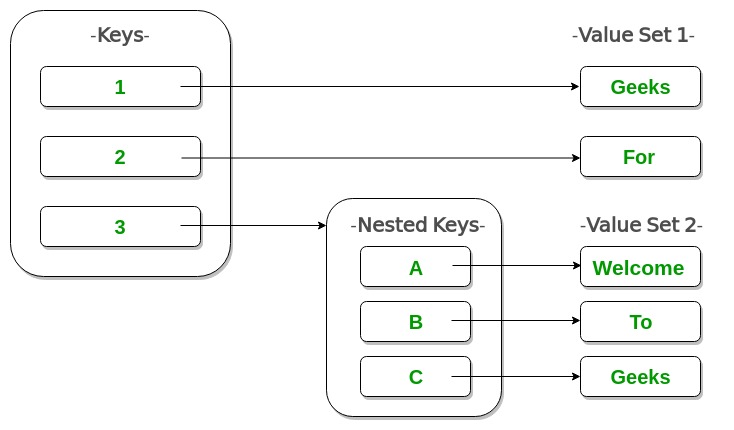Python嵌套字典
先决条件 - Python字典
Python中的字典与现实世界中的字典类似。字典的键必须是唯一的并且是不可变的数据类型,例如字符串、整数和元组,但键值可以重复并且可以是任何类型。
嵌套字典:嵌套字典意味着将一个字典放在另一个字典中。嵌套非常有用,因为我们可以在程序中建模的信息类型得到了极大的扩展。
Python3
nested_dict = { 'dict1': {'key_A': 'value_A'},
'dict2': {'key_B': 'value_B'}}Python3
# As shown in image
# Creating a Nested Dictionary
Dict = {1: 'Geeks', 2: 'For', 3: {'A' : 'Welcome', 'B' : 'To', 'C' : 'Geeks'}}Python3
# Empty nested dictionary
Dict = { 'Dict1': { },
'Dict2': { }}
print("Nested dictionary 1-")
print(Dict)
# Nested dictionary having same keys
Dict = { 'Dict1': {'name': 'Ali', 'age': '19'},
'Dict2': {'name': 'Bob', 'age': '25'}}
print("\nNested dictionary 2-")
print(Dict)
# Nested dictionary of mixed dictionary keys
Dict = { 'Dict1': {1: 'G', 2: 'F', 3: 'G'},
'Dict2': {'Name': 'Geeks', 1: [1, 2]} }
print("\nNested dictionary 3-")
print(Dict)Python3
Dict = { }
print("Initial nested dictionary:-")
print(Dict)
Dict['Dict1'] = {}
# Adding elements one at a time
Dict['Dict1']['name'] = 'Bob'
Dict['Dict1']['age'] = 21
print("\nAfter adding dictionary Dict1")
print(Dict)
# Adding whole dictionary
Dict['Dict2'] = {'name': 'Cara', 'age': 25}
print("\nAfter adding dictionary Dict1")
print(Dict)Python3
# Nested dictionary having same keys
Dict = { 'Dict1': {'name': 'Ali', 'age': '19'},
'Dict2': {'name': 'Bob', 'age': '25'}}
# Prints value corresponding to key 'name' in Dict1
print(Dict['Dict1']['name'])
# Prints value corresponding to key 'age' in Dict2
print(Dict['Dict2']['age'])Python3
Dict = {'Dict1': {'name': 'Ali', 'age': 19},
'Dict2': {'name': 'Bob', 'age': 21}}
print("Initial nested dictionary:-")
print(Dict)
# Deleting dictionary using del keyword
print("\nDeleting Dict2:-")
del Dict['Dict2']
print(Dict)
# Deleting dictionary using pop function
print("\nDeleting Dict1:-")
Dict.pop('Dict1')
print (Dict)
Python3
# As shown in image
# Creating a Nested Dictionary
Dict = {1: 'Geeks', 2: 'For', 3: {'A' : 'Welcome', 'B' : 'To', 'C' : 'Geeks'}}
创建嵌套字典
在Python中,可以通过将逗号分隔的字典放在大括号内来创建嵌套字典。
Python3
# Empty nested dictionary
Dict = { 'Dict1': { },
'Dict2': { }}
print("Nested dictionary 1-")
print(Dict)
# Nested dictionary having same keys
Dict = { 'Dict1': {'name': 'Ali', 'age': '19'},
'Dict2': {'name': 'Bob', 'age': '25'}}
print("\nNested dictionary 2-")
print(Dict)
# Nested dictionary of mixed dictionary keys
Dict = { 'Dict1': {1: 'G', 2: 'F', 3: 'G'},
'Dict2': {'Name': 'Geeks', 1: [1, 2]} }
print("\nNested dictionary 3-")
print(Dict)
输出:
Nested dictionary 1-
{'Dict1': {}, 'Dict2': {}}
Nested dictionary 2-
{'Dict1': {'name': 'Ali', 'age': '19'}, 'Dict2': {'name': 'Bob', 'age': '25'}}
Nested dictionary 3-
{'Dict1': {1: 'G', 2: 'F', 3: 'G'}, 'Dict2': {1: [1, 2], 'Name': 'Geeks'}}向嵌套字典添加元素
可以通过多种方式将元素添加到嵌套字典中。在嵌套字典中添加字典的一种方法是一对一地添加值,Nested_dict[dict][key] = 'value'。另一种方法是一次性添加整个字典,Nested_dict[dict] = { 'key': 'value'}。
Python3
Dict = { }
print("Initial nested dictionary:-")
print(Dict)
Dict['Dict1'] = {}
# Adding elements one at a time
Dict['Dict1']['name'] = 'Bob'
Dict['Dict1']['age'] = 21
print("\nAfter adding dictionary Dict1")
print(Dict)
# Adding whole dictionary
Dict['Dict2'] = {'name': 'Cara', 'age': 25}
print("\nAfter adding dictionary Dict1")
print(Dict)
输出:
Initial nested dictionary:-
{}
After adding dictionary Dict1
{'Dict1': {'age': 21, 'name': 'Bob'}}
After adding dictionary Dict1
{'Dict1': {'age': 21, 'name': 'Bob'}, 'Dict2': {'age': 25, 'name': 'Cara'}}访问嵌套字典的元素
为了访问嵌套字典中任何键的值,请使用索引 [] 语法。
Python3
# Nested dictionary having same keys
Dict = { 'Dict1': {'name': 'Ali', 'age': '19'},
'Dict2': {'name': 'Bob', 'age': '25'}}
# Prints value corresponding to key 'name' in Dict1
print(Dict['Dict1']['name'])
# Prints value corresponding to key 'age' in Dict2
print(Dict['Dict2']['age'])
输出:
Ali
25从嵌套字典中删除字典
从嵌套字典中删除字典可以通过使用 del 关键字或使用 pop()函数来完成。
Python3
Dict = {'Dict1': {'name': 'Ali', 'age': 19},
'Dict2': {'name': 'Bob', 'age': 21}}
print("Initial nested dictionary:-")
print(Dict)
# Deleting dictionary using del keyword
print("\nDeleting Dict2:-")
del Dict['Dict2']
print(Dict)
# Deleting dictionary using pop function
print("\nDeleting Dict1:-")
Dict.pop('Dict1')
print (Dict)
输出:
Initial nested dictionary:-
{'Dict2': {'name': 'Bob', 'age': 21}, 'Dict1': {'name': 'Ali', 'age': 19}}
Deleting Dict2:-
{'Dict1': {'name': 'Ali', 'age': 19}}
Deleting Dict1:-
{}